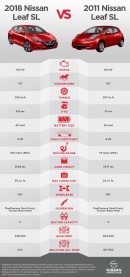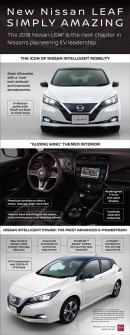When Nissan introduced the first-generation Leaf in 2010 for the 2011 model year, the naysayers couldn’t anticipate the compact hatchback would become the world’s best-selling electric car by a significant margin. 2018 marks the arrival of the second-generation Leaf, which means that it’s high time to discuss what changed during this past handful of years.
Coming courtesy of Nissan Parts Plus, the comparison infographic serving as the lead image of this story shows the extent of what’s what. In SL configuration, the Leaf now boasts 110 kW of all-electric power instead of 80 kW the predecessor had to its name. It won’t be long now, and the Japanese automaker will add an even more potent powertrain to the lineup.
Torque, which is instant thanks to the electric drivetrain, also went up from 207 to 236 pound-feet, translating to improved 0-to-60 acceleration: 10 versus 8.8 seconds. In regard to range, the newcomer can be driven an EPA-estimated 150 miles thanks to 40 kWh of e-juice. The original, on the other hand, came with a 24-kWh battery capable of delivering 73 miles.
Though heavier (3,508 compared to 3,375 pounds), the 2018 Nissan Leaf is more aerodynamic (Cd 0.28 versus 0.29) and roomier than the model it replaces. The 106-inch wheelbase and torsion beam rear suspension remain, though maximum cargo capacity goes up from 24 to 30 cubic feet.
Now’s the time to talk pricing, which favors the 2018 model year. Starting at $36,200, the all-new Leaf undercuts its predecessor by more than a grand. Adjusted for inflation, the original MSRP of $34,540 converts to $37,550, meaning that the second-generation Leaf offered superior value.
Though Nissan never had a knack for building the hype Tesla relies upon for selling its electric vehicles, the Leaf is an unsung hero of electrification. Relatively inexpensive, adequately reliable, and the low cost of ownership makes it a tempting proposition for first-time EV buyers and customers who aren't ready to shop more expensive, premium-oriented electric vehicles.
Torque, which is instant thanks to the electric drivetrain, also went up from 207 to 236 pound-feet, translating to improved 0-to-60 acceleration: 10 versus 8.8 seconds. In regard to range, the newcomer can be driven an EPA-estimated 150 miles thanks to 40 kWh of e-juice. The original, on the other hand, came with a 24-kWh battery capable of delivering 73 miles.
Though heavier (3,508 compared to 3,375 pounds), the 2018 Nissan Leaf is more aerodynamic (Cd 0.28 versus 0.29) and roomier than the model it replaces. The 106-inch wheelbase and torsion beam rear suspension remain, though maximum cargo capacity goes up from 24 to 30 cubic feet.
Now’s the time to talk pricing, which favors the 2018 model year. Starting at $36,200, the all-new Leaf undercuts its predecessor by more than a grand. Adjusted for inflation, the original MSRP of $34,540 converts to $37,550, meaning that the second-generation Leaf offered superior value.
Though Nissan never had a knack for building the hype Tesla relies upon for selling its electric vehicles, the Leaf is an unsung hero of electrification. Relatively inexpensive, adequately reliable, and the low cost of ownership makes it a tempting proposition for first-time EV buyers and customers who aren't ready to shop more expensive, premium-oriented electric vehicles.











































